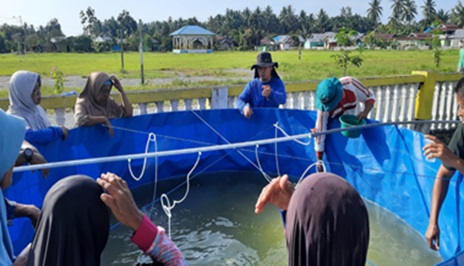Pemberdayaan Kelompok Pembudidaya Ikan Desa Pakowa Bunta dengan Menggunakan Ekstrak Daun Sirih (Piper betle L.) dalam Pakan pada Budidaya Ikan Nila Sistem Bioflok Empowerment of the Pakowa Bunta Village Fish Cultivator Group Using Betel Leaf Extract (Piper betle L.) in Feed in Biofloc System Tilapia Cultivation
Main Article Content
Abstract
Pakowa Bunta Village is one of the villages in Nuhon District, Banggai Regency, physically it is a lowland area located on the coastline. The large area of tilapia ponds in Pakowa Bunta Village and the suboptimal management of tilapia cultivation have caused many tilapia fish to die. The repeated failure of cultivation in the traditional system of tilapia cultivation in Pakowa Bunta Village requires the transfer of innovative fish cultivation technology from the traditional system to the biofloc system. This community service activity aims to improve the skills and knowledge of fish cultivator groups regarding biofloc system fish cultivation and increase the economic income of fish cultivators in Pakowa Bunta Village. The approach used to resolve partner problems in this activity is the Community Development method, which is oriented towards developing community empowerment by making the community the subject and object of development and direct involvement in various service activities. The final result achieved from this community service activity is an increase in the skills of the fish cultivator group in innovating tilapia cultivation technology using a biofloc system that is modified by using betel leaf extract in the feed given to tilapia, resulting in an increase in tilapia production and an increase in the community's economic income of fish farmers.
Downloads
Article Details

This work is licensed under a Creative Commons Attribution-ShareAlike 4.0 International License.
Authors who publish with this journal agree to the following terms:
- Any article on the copyright is retained by the author(s).
- Author grant the journal, right of first publication with the work simultaneously licensed under a Creative Commons Attribution License that allows others to share work with acknowledgment of the work authors and initial publications in this journal.
- Authors are able to enter into a separate, additional contractual arrangements for non-exclusive distribution of published articles of work (eg, post-institutional repository) or publish it in a book, with acknowledgment of its initial publication in this journal.
- Authors are permitted and encouraged to post their work online (e.g., in institutional repositories or on their websites) prior to and during the submission process, as can lead to productive exchanges, as well as earlier and greater citation of published work.
- The article and any associated published material is distributed under the Creative Commons Attribution-ShareAlike 4.0 International License
References
Agustina, S. S. 2022. Metode Pemberian Pakan Dengan Ekstrak Daun Sirih (Piper betle L.) Pada Ikan Nila (Oreochromis niloticus). S00202214108, issued 2022.
Agustina, S. S., R. Rosilawati, and Y. Saraswati. 2016. PEMBERDAYAAN MASYARAKAT DENGAN PENGEMBANGAN POTENSI SUMBERDAYA ALAM DI DESA PAKOWA BUNTA KECAMATAN NUHON KABUPATEN BANGGAI. Jurnal Pengabdian Masyarakat Kreatif 2 (1): 37–45. http://dx.doi.org/10.31219/osf.io/42abe
Agustina, S. S., Tasruddin, Faisal, and Mahmud. 2022. Penggunaan Ekstrak Daun Piper Betle L. Dalam Pakan (Pellet) Terhadap Pertumbuhan Dan Rasio Konversi Pakan Ikan Nila (Oreochromis Niloticus). Techno Fish 6 (2): 100–108. https://doi.org/10.25139/tf.v6i2.5208
Agustina, S.S., Yanti Mutalib, and Afif Bakri. 2018. “Uji Daya Antiparasit Konsentrasi Ekstrak Piper Betle L. Terhadap Parasit Trichodina Sp. Yang Menginfeksi Benih Ikan Nila (Oreochromis Niloticus). In Prosiding Seminar Nasional Kelautan XIII, 9–16. Fakultas Teknik dan Ilmu Kelautan Universitas Hang Tuah. Surabaya.
Fanani, Ahmad Nizar, Boedi Setya Rahardja, and Prayogo. 2018. Efek Padat Tebar Ikan Lele Dumbo (Clarias Sp.) Yang Berbeda Terhadap Kandungan Amonia (NH3) Dan Nitrit (NO2) Dengan Sistem Bioflok. Journal of Aquaculture Science 3 (2): 182–90.
Kurniaji, Ardana, Yunarty Yunarty, Anton Anton, Zainal Usman, Eriyanti Wahid, and Kristomy Rama. 2021. Pertumbuhan Dan Konsumsi Pakan Ikan Nila (Oreochromis Niloticus) Yang Dipelihara Dengan Sistem Bioflok. Sains Akuakultur Tropis 5 (2): 197–203. https://doi.org/10.14710/sat.v5i2.11824 .
Munaeni, Waode, M. Aris, and Sulfi Abdul Haji. 2022. Usaha Budidaya Ikan Nila Sistem Bioflok Di Kelurahan Fitu Kecamatan Ternate Selatan Maluku Utara. Jurnal Pengabdian Kepada Masyarakat Nusantara (JPkMN) 3 (2): 660–68.
Nite, Ridwan Meldi, and Nurbety Tarigan. 2021. Laju Pertumbuhan Ikan Nila (Oreocromis Niloticus) Yang Dipelihara Dengan Menggunakan Sistem Bioflok di Kabupaten Sumba Timur. Marinade 4 (01): 10–15. https://doi.org/10.31629/marinade.v4i1.3409 .
Sadiah, Hilma Halimatus, Adi Imam Cahyadi, and Sarasati Windria. 2022. Kajian Daun Sirih Hijau (Piper Betle L) Sebagai Antibakteri. Jurnal Sain Veteriner 40 (2): 128. https://doi.org/10.22146/jsv.58745 .
Safsafubun, Franklin Romero, Suzanne L. Undap, R.N. Indra Salindeho, PangemananP.L. Novie, Juliaan Ch. Watung, and Henneke Pangkey. 2023. Fluktuasi Parameter Kualitas Air dan Perkembangan Flok Pada Budidaya Ikan Nila (Oreochromis Niloticus) Dengan Sistem Bioflok Di BPBAT Talelu. E-Journal Budidaya Perairan 11 (2): 213–26. https://doi.org/10.14341/cong23-26.05.23-39 .
Saridu, Siti Aisyah, Ani Leilani, Diana Putri Renitasari, Muhammad Syharir, and Karmila Karmila. 2023. Pembesaran Ikan Nila (Oreochromis Niloticus) Dengan Sistem Bioflok. Jurnal Vokasi Ilmu-Ilmu Perikanan (Jvip) 3 (2): 90. https://doi.org/10.35726/jvip.v3i2.6559 .
Setiyanti, Anis. 2022. Praktik Diskusi Sarasehan Dengan Pendekatan Community Development. Misykat Al-Anwar Jurnal Kajian Islam Dan Masyarakat 5 (1): 1. https://doi.org/10.24853/ma.5.1.1-15 .
Sukardi, Purnama, Petrus Hary, Tjahja Soedibya, and Taufik Budhi Pramono. 2018. Produksi Budidaya Ikan Nila (Oreochromis Niloticus) Sistem Bioflok Dengan Sumber Karbohidrat Berbeda. Asian Journal of Innovation and Entrepreneurship 03 (02): 198–203.
Sumitro, Arfan Afandi, Kurniawan Wahyu Hidayat, and Rifqah Pratiwi. 2020. Evaluasi Beberapa Desain Pipa Mikropori Sebagai Sistem Aerasi Dalam Budidaya Ikan Lele (Clarias Gariepinus) Intensif Berbasis Teknologi Bioflok. Journal of Aquaculture and Fish Health 9 (2): 114. https://doi.org/10.20473/jafh.v9i2.16692 .
Sumitro, Said Saleh Salihi, Budiyanti, Supasman Emu, Tamar Mustari, Wa Ode Safia, Wardha Jalil, and Arfan Afandi. 2023. Pengembangan Budidaya Ikan Lele Clarias Gariepinus INTENSIF Berbasis Teknologi Bioflok Di Kelurahan Liabuku Kota Baubau Provinsi Sulawesi Tenggara. PengabdianMu: Jurnal Ilmiah Pengabdian Kepada Masyarakat 8 (4): 489–95. https://doi.org/10.33084/pengabdianmu.v8i4.4297
